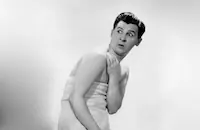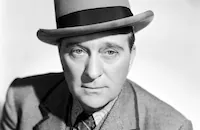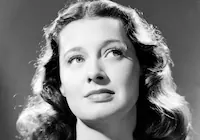Star Spangled Rhythm

Brief Synopsis
Cast & Crew
George Marshall
Bing Crosby
Bob Hope
Fred Macmurray
Franchot Tone
Ray Milland
Film Details
Technical Specs

Synopsis
When Navy sailor Johnny Webster comes ashore with his pals for a twenty-four hour leave in the Los Angeles area, he calls his father "Pop" at Paramount studios. Pop, a former silent movie Western star known as "Bronco Billy," has told Johnny that he is the executive vice-president in charge of production at Paramount, because he is too embarrassed to admit that he is only the gateman. Switchboard operator Polly Judson helps Pop keep up the farce by pretending to be his secretary every time Johnny calls, and has fallen in love with Johnny just from his photo. In order to maintain the ruse, Polly calls Sarah, the secretary to B. G. De Soto, the real executive producer, and tells her that De Soto has taken ill and wants her to work at his house. When Johnny, Hi-Pockets and the other sailors arrive, they meet Pop, wearing a beret and a natty suit, and Polly, in De Soto's office. The sailors are impressed by Pop's position, especially when performer Cass Daley comes in for an audition. Pop makes a mess of De Soto's office by unintentionally pressing automatic buttons that turn on the fans and display the hidden bar. When famous director Cecil B. DeMille telephones to ask De Soto's advice on some new footage he sent him, Pop tells him it stinks. Outraged, DeMille shows up at De Soto's office, and Polly, Pop and the sailors run out. De Soto, meanwhile, arrives at the studio but is blocked from entering by the guard, who is under orders from Polly, who also has told De Soto that he was fired that morning. Polly, Pop and the sailors slip into a screening room where director Preston Sturges is viewing a musical number featuring Dick Powell and Mary Martin. Believing that De Soto is with the group, Sturges runs the film for them, and is extremely insulted when he finishes and De Soto has apparently slipped out. The group next stops at a sound stage where a big music and dance sequence is being shot, but when Hi-Pockets is unable to contain himself any longer and starts dancing with singer Dona Drake, director Ralph Murphy throws them off the set. In order to avoid being caught out of uniform, Pop takes the day off and shows the sailors around town, and casually mentions that he would have put on a star-studded performance for the sailors if only they had more shore leave. Johnny, Hi-Pockets and the others finally return to the ship, and Johnny asks the captain's permission to marry Polly. Although the captain grants permission, he cannot allow any more shore leave as he is waiting for orders. When Johnny mentions that his prestigious father offered to put on a variety show, the captain agrees to allow all the soldiers to go to the canteen auditorium the next night for the show. The next morning, Johnny calls Polly and tells her the "good" news, and Polly is terrified that she is now expected to fulfill Pop's idle promise. She immediately gets to work impersonating Sarah and asking Bob Hope to commit his evening to the benefit, but De Soto catches her and Pop in his office and fires them both. Pop is disconsolate, but Polly refuses to give up, and beseeches Hope and Bing Crosby to do the benefit for Pop's sake. Both actors agree and offer to enlist other stars on the lot. At 4:30 in the afternoon, De Soto is astonished when he sees all of his highly-paid stars leaving early, and follows them to the auditorium. At six o'clock, as Pop goes on stage to apologize to the soldiers for failing them, Bing Crosby and a host of other big names appear behind him, and the show begins, with Bob Hope as the emcee. When Johnny learns that De Soto has arrived with the intention of stopping the show, he and the sailors bind and gag him. During the performance, De Soto escapes but is unable to interrupt the proceedings. The head of all production, Y. Frank Fremont, then arrives, and when Polly confesses all, he is delighted by her and Pop's ingenuity and offers to rehire them both. The sailors are called to duty, and Johnny gives Polly his ring and a farewell kiss, as Bing Crosby finishes with a patriotic song dedicated to the American flag.

Director

George Marshall
Cast

Bing Crosby

Bob Hope

Fred Macmurray

Franchot Tone

Ray Milland

Victor Moore

Dorothy Lamour

Paulette Goddard
Vera Zorina

Mary Martin

Dick Powell

Betty Hutton

Eddie Bracken

Veronica Lake

Alan Ladd

Rochester

William Bendix
Jerry Colonna

Macdonald Carey

Walter Abel

Susan Hayward

Marjorie Reynolds
Betty Rhodes

Dona Drake

Lynne Overman

Gary Crosby
Johnnie Johnston
Gil Lamb
Cass Daley

Ernest Truex

Katherine Dunham

Arthur Treacher

Walter Catlett

Sterling Holloway
Golden Gate Quartette
Walter Dare Wahl

Cecil B. Demille

Preston Sturges
Ralph Murphy

Ellen Drew

Jimmy Lydon
Charles Smith

Frances Gifford
Susanna Foster

Robert Preston
Louise Laplanche
Donivee Lee
Christopher King
Alice Kirby
Marcella Phillips

Anne Revere
Edward Fielding
Edgar Dearing
Frank Faylen
William Haade
Maynard Holmes

James Millican
Eddie Johnson
Arthur Loft

Woodrow W. Strode

Marion Martin
Chester Clute
Maxine Ardell
Marjorie Deanne
Lorraine Miller
Boyd Davis
Frank Moran
Eddie Dow
Rod Cameron
John Shay
Barney Dean
Jack Hope
Keith Richards
Jack Roberts
Katharine Booth
Gladys Blake
Don Castle
Frederic Henry
Sherman Sanders
Tom Dugan
Paul Porcasi

Richard Loo
Slim And Slam

Irving Bacon
Virginia Brissac
Matt Mchugh
Peter Potter
Edward J. Marr
Dorothy Granger

Barbara Pepper
Jean Phillips
Lynda Grey
Champ, A Dog
Crew
Lewis Allen
Harold Arlen
George Balanchine
Arthur Black
John Cope
Danny Dare
B. G. Desylva
Robert Emmett Dolan
Jack Donohue
Hans Dreier
Jimmy Dundee
Ernst Fegté
Melvin Frank
Arthur Franklin
Edith Head
George Kaufman
Sam Ledner
Joseph J. Lilley
Johnny Mercer
Harry Mills
Ralph Murphy
Norman Panama
Arthur Phillips
Billy Rose
Arthur Ross
Fred Saidy
Steve Seymour
Joseph Sistrom
Theodor Sparkuhl
A. Edward Sutherland
Leo Tover
Harry Tugend
Frank Tuttle
William Watson
Paul Weatherwax
Paul Weatherwax
Wally Westmore

Film Details
Technical Specs

Award Nominations
Best Score
Best Song
Best Song
Articles
Star Spangled Rhythm
Unlike Big Broadcast, however, Star Spangled Rhythm features not just a cast of major stars playing characters, but a bevy of additional stars appearing as themselves. The film was one of many all-star vehicles produced during World War II as escapist morale boosters - a way of giving audiences the delight of seeing more stars in one film than ever before. Warner Bros., for instance, made Thank Your Lucky Stars (1943) and Hollywood Canteen (1944); MGM produced Thousands Cheer (1943); United Artists made Stage Door Canteen (1943); and Universal turned out Follow the Boys (1944). They all followed roughly the same formula of using wispy plots to give multiple stars the chance to appear in song-and-dance numbers, comedy sketches and the like. As a result, these films wound up paying tribute as much to the particular studios themselves as to the national war effort.
Star Spangled Rhythm is even set on the Paramount studio lot, with Betty Hutton playing a switchboard operator who falls for Navy sailor Eddie Bracken just from his photo. Bracken's father is an old silent western star (Victor Moore) who now works as the studio gateman, though he has told Bracken he is a senior executive. When Bracken comes to visit the studio on leave, Hutton and Moore go into overdrive to keep up the deception, with comic results. There are plenty of in-jokes: real-life executive producer Buddy De Sylva is spoofed by Walter Abel as the film's "B. G. De Soto," and real Paramount vice president Y. Frank Freeman is played by Edward Fielding as "Y. Frank Freemont." (Freeman was a southerner and loved Coca-Cola; hence "Freemont" is seen pouring himself a Coke.) At one point, Moore is wreaking havoc in De Soto's office when Cecil B. De Mille calls to ask what the producer thinks of his new film, Reap the Wild Wind (1942). "It stinks," says Moore, because that's how he's been told to impersonate an executive - just to say "it stinks" to every question.
Director Preston Sturges appears as himself, too, but mainly the story is an excuse for over two dozen stars to appear as themselves, among them Bob Hope, Bing Crosby, Fred MacMurray, Ray Milland, Franchot Tone, Alan Ladd, Dorothy Lamour, Paulette Goddard, Susan Hayward, Dick Powell, William Bendix, Eddie "Rochester" Anderson, Vera Zorina, Albert Dekker, Veronica Lake, Susan Hayward, Marjorie Reynolds and Robert Preston. There's even a glimpse of future star Woody Strode, as Rochester's chauffeur. Crosby's nine-year-old son, Gary Crosby, can also be seen with his father.
Among the many skits and numbers is the introduction of a new song destined to become a standard: "That Old Black Magic," which is performed by Vera Zorina and would score an Oscar nomination for Harold Arlen and Johnny Mercer, who wrote all eight of the movie's songs. Elsewhere, Alan Ladd parodies his film noir image in a sketch with MacDonald Carey, Marjorie Reynolds and leads a song set on an aircraft assembly line, Crosby sings the flag-waver "Old Glory," and Lamour, Lake and Goddard team up for the famous time-capsule "A Sweater, Sarong, and a Peek-a-Boo Bang." Lake later wrote that this number "was dreadful, but fun." Afterwards, Bob Hope stepped up and asked her if she was saving her money. Why, she asked. "With a voice like that, you'll need it." "He was right," Lake wrote. "I never could sing."
Variety deemed the film "fresh, alive, and full of bounce... Only trouble exhibs will have in selling Star Spangled Rhythm will be in finding a marquee big enough to hold all the names."
By Jeremy Arnold

Star Spangled Rhythm
Ellen Drew, 1914-2003
She was born Esther Loretta "Terry" Ray on November 23, 1914, in Kansas City, Missouri. The daughter of a barber, her family moved to Chicago when she was still an infant and she lived a very quiet childhood far removed from the glamour of Hollywood. She was encouraged by some friends to enter a beauty contest when she was just 17. After winning, she tried her luck in Hollywood, but found that they were no immediate offers for her particular talents.
She eventually took a waitressing job at C.C. Brown's, a famed Hollywood Boulevard soda fountain, and had virtually abandoned her dreams as a starlet when William Demarest, a popular actor's agent and well-known character actor, spotted her. Demarest arranged a screen test for her at Paramount, and she was promptly placed under contract for $50 a week.
For the first few years, (1936-38), Drew got only bit parts, and was often uncredited. When she finally got prominent billing in the Bing Crosby musical Sing You Sinners (1938), she decided to change her name, from Terry Ray to Ellen Drew. She earned her first major role in Frank Lloyd's If I Were King (1938) opposite Ronald Colman, yet for the most part of her career, rarely rose above "B" material and second leads. Still, she had some fine exceptions: Preston Sturges' enchanting comedy Christmas in July (1940), with Dick Powell; Tay Garnett's lighthearted war romp My Favorite Spy (1942) co-starring Kay Kyser; Julien Duvivier's taut The Imposter (1944), holding her own with a brooding Jean Gabin; and Mark Robson's chilling low-budget chiller Isle of the Dead (1945) opposite Boris Karloff. Drew made some notable television appearances in the late '50s including Perry Mason and The Barbara Stanwyck Show, before retiring from the entertainment industry. She is survived by her son David; five grandchildren; and five great-grandchildren.
by Michael T. Toole
Ellen Drew, 1914-2003
Quotes
Germans, Italians, and Japs / Can't kick us off our Rand-McNally maps.- Bing Crosby
Trivia
Notes
The working title of this film was Thumbs Up. Although Eddie Bracken's character is listed as "Jimmy Webster" in the CBCS, he is called "Johnny" in the film. As noted in the Variety review, the picture features comic portrayals of various Paramount studio executives, including Walter Abel as "B. G. DeSoto," who is modeled after executive producer B. G. DeSylva, and Edward Fielding as "Y. Frank Freemont," who is modeled after studio vice-president Y. Frank Freeman. According to information in the Paramount Collection at the AMPAS Library, Paramount paid Arthur Ross and Fred Saidy for the rights to two sketches written for the musical revue Rally 'Round the Girls, which was produced in Hollywood in March 1942. The Paramount Collection also indicates that William Watson, Frank Tuttle, Lewis Allen and Paul Weatherwax assisted in the direction of this film; however, the scope of their contributions to the completed film has not been determined.
Hollywood Reporter news items reported the following about the production: René Clair was slated to direct the "That Old Black Magic" number, but was unavailable at the time. This film marks the feature film debut of Bing Crosby's son Gary. Some "sketches" in Star Spangled Rhythm were originally written by Arthur Ross and Fred Saidy for an unproduced musical titled Rally Round the Girls. The film's final cost was $1,127,989. News items in 1943 reported that Max Aronson, better known as "Broncho Billy," filed a $900,000 lawsuit against Paramount for using the "Broncho Billy" name. Aronson, who was renowned as one of the first motion picture stars and creator of the Western character "Broncho Billy," protested that Paramount was portraying him as a "washed-up and broken-down actor." The final outcome of this lawsuit has not been determined. Actor Tom Dugan, who briefly portrays "Hitler" in the musical revue in this film, also portrays an actor playing Adolf Hitler in United Artists' film To Be or Not to Be (see below). This film was nominated for Academy Awards for Best Song ("That Old Black Magic") and Best Scoring of a Musical Picture.

Miscellaneous Notes
Released in United States 1942
Released in United States 1942













